Note: This website was automatically translated, so some terms or nuances may not be completely accurate.
A New Certification System Changing the Value Standards of the Fashion Industry

Tetsuya Yamashita
ITOCHU Fashion System Corporation

Naoki Hagiwara
Urban Research Co., Ltd.

Ikumi Toga
Dentsu Inc.
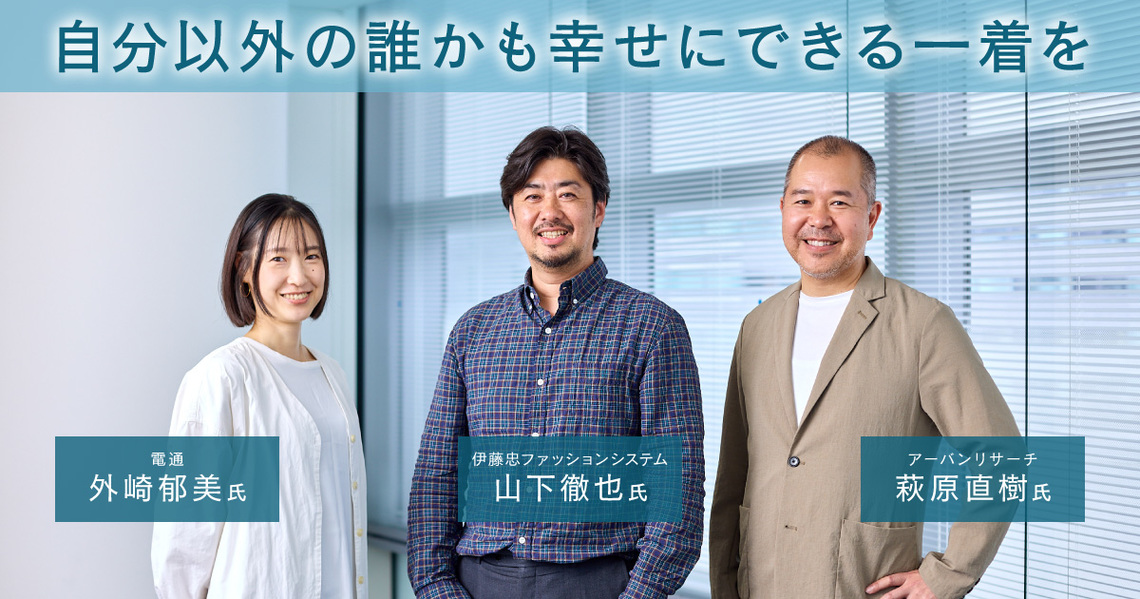
As sustainability gains importance in the fashion industry, movements are emerging to "visualize" corporate and brand initiatives and build new relationships with consumers and society. " Re-Creation," launched by ITOCHU Fashion System, is one such challenge.
This project develops a certification scheme to visualize companies' sustainable initiatives and present them to society as a trustworthy mechanism. It aims to create opportunities for consumers, when selecting products, to consider not only price and design but also whether their choice is mindful of the environment and production sites. The goal is for both the industry as a whole and consumers to jointly recreate the value chain.
Why did ITOCHU Fashion System take the lead and develop this new certification standard? And what is the vision behind Urban Research, the first company to adopt this certification?
Tetsuya Yamashita from ITOCHU Fashion System's ifs Future Research Institute, Naoki Hagiwara, Executive Officer of Urban Research, and Ikumi Totsuki from Dentsu Inc., who has been involved in designing Re-Creation's communication strategy and participating in the committee organization, discussed these topics.
<Table of Contents>
▼Challenging Social Change with New Certification Standards
▼Choosing "Someone's Happiness" Beyond Materials, Price, and Design
▼Urban Research: Pioneering Sustainability in the Industry
▼Behavioral Change Starts with "Awareness": Creating Triggers for Consumer Transformation
▼To Remain a Trusted Certification, Continuously Supporting Consumer Choices
Challenging Social Change with New Certification Standards
Tozaki: First, could you remind us what kind of organization Re-Creation is?
Yamashita: Re-Creation is a general incorporated association established by ITOCHU Fashion System. Starting in autumn 2024, beginning with the fashion industry, we launched our own sustainability certification targeting apparel and fashion accessories. Rather than assessing companies as a whole, we evaluate products individually. Items meeting our standards receive a QR code, enabling us to deliver information to consumers and encourage behavioral change. Our certification criteria are publicly available on our website, making corporate initiatives transparent and helping consumers make informed choices. Through this initiative, we aim to foster reliable and transparent communication between producers and consumers.
Tozaki: I understand this was meticulously prepared from the conceptual stage. Could you share the background leading up to its launch?
Yamashita: The concept itself dates back three years. We conducted interviews with approximately 400 to 500 individuals involved in the fashion industry, organizing challenges and exploring direction. What became clear was that solving the industry's structural issues required not only corporate initiatives but also a unified shift in consumer behavior. When we presented the concept at an exhibition in April 2023, the response exceeded expectations, drawing interest from both inside and outside the industry. Half a year later, we received an invitation to speak at an even larger event. This opportunity allowed us to present alongside Professor Norifumi Kanie of Keio University, with whom we had previously collaborated on SDGs research. This platform gradually sparked collaborations with diverse stakeholders: universities, media, advertising agencies, international certification bodies, government, and finance.
Tozaki: What were the key reasons for launching Re-Creation as a general incorporated association rather than a corporation?
Yamashita: A corporation inevitably carries a profit-driven impression and creates psychological barriers when working across corporate and industry boundaries. A general incorporated association, however, has a structure where profits are reinvested into activities rather than distributed to shareholders. We believed that the clearer the purpose, the easier it would be to attract broader participation. Additionally, it holds significance as the first general incorporated association within the Itochu Group. We position this initiative as non-financial information, or what we call "future finance." If we were solely pursuing profit, we would have established a corporation. But as the general incorporated association Re-Creation, our primary focus is on how to generate social value.
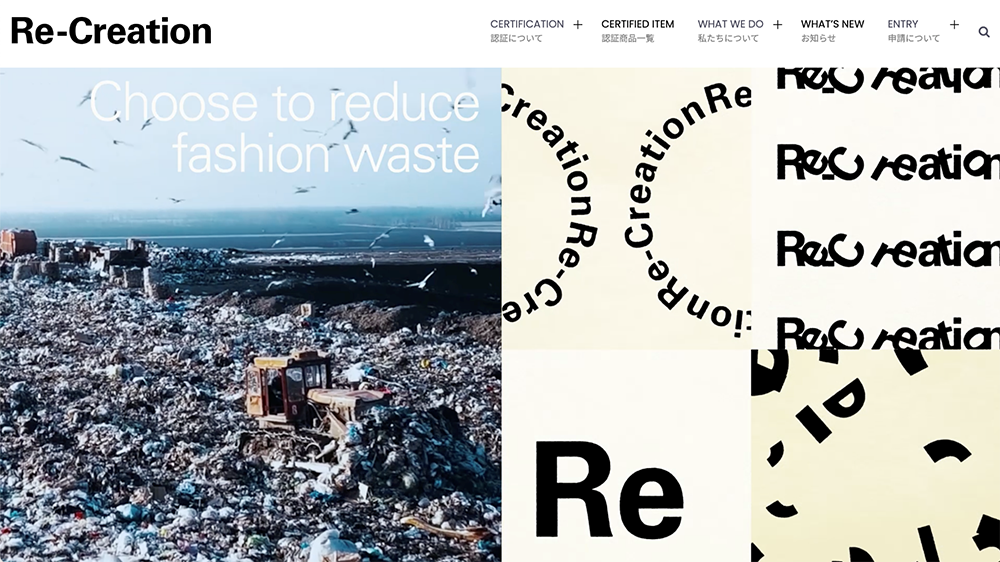
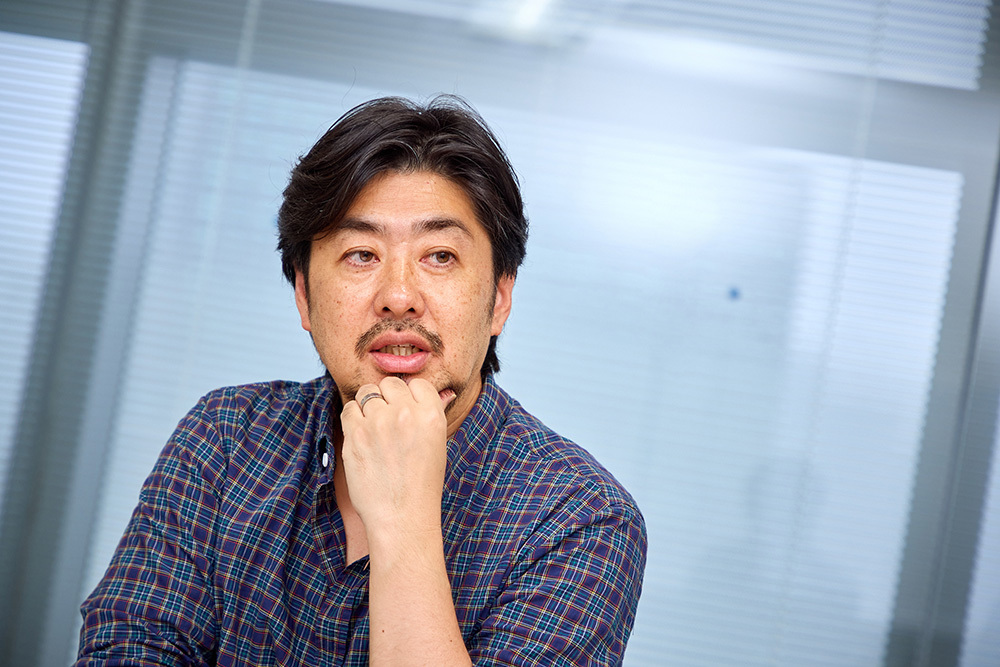
Tozaki: I'd also like to ask about the background and purpose behind developing these certification standards.
Yamashita: We believe fashion should inherently enrich lives and uplift spirits. However, it's also true that in recent years, complex issues like excess inventory, environmental pollution, and labor problems have intertwined, giving the entire industry a negative impression. We feel a key factor behind this was the lack of a proper evaluation system. Re-Creation's certification standards were developed as a new metric to establish clear benchmarks for these challenges and communicate them clearly to consumers.
Tozaki: So those 10 certification criteria items form that benchmark. What points did you prioritize when designing them?
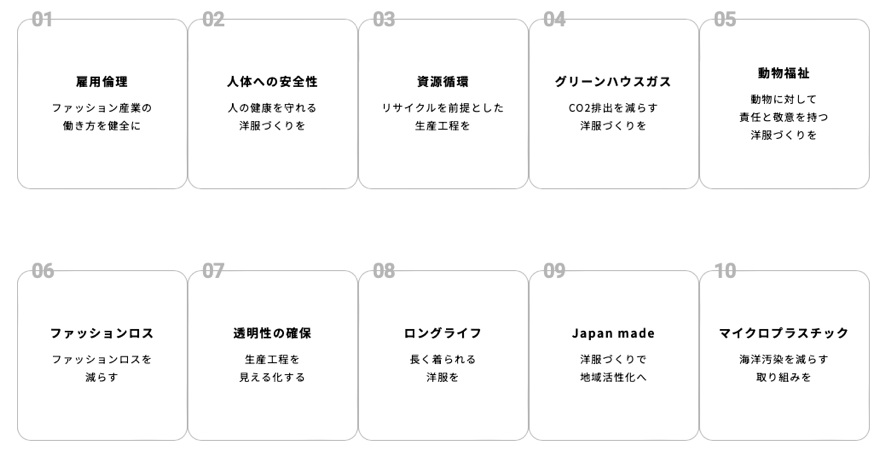
Yamashita: Our focus was on designing criteria rooted in critical issues, not just creating a checklist. For example, organic cotton is widely known in Japan as a "skin-friendly material," but its true significance lies in reducing pesticide use, protecting water quality and soil, and improving producers' working conditions. At Re-Creation, we consciously returned to these fundamental perspectives and aimed to clearly communicate the underlying critical issues.
Tozaki: Did you also consider alignment with international certification standards?
Yamashita: Given the reality that 98% of clothing circulating in the Japanese market is produced overseas, adopting a global standard perspective was essential. We carefully designed the system from a consumer-friendly perspective, referencing numerous existing international standards and scientific evidence. However, international certifications often have high barriers to entry, leading to low consumer recognition. Therefore, Re-Creation also incorporates perspectives focused on cost optimization and streamlining processes to reduce complexity.
Choosing "someone's happiness" beyond material, price, and design
Sotozaki: When launching Re-Creation, we also supported the communication design process. This led to the concept: "With that one piece, renew the world." Could you share the thoughts behind this phrase?
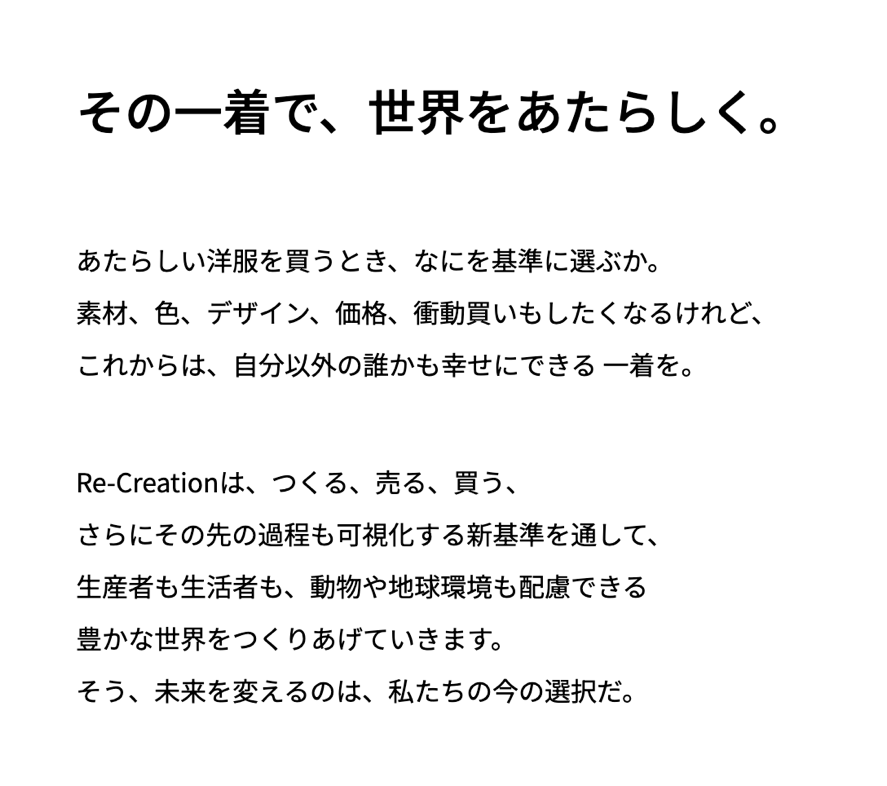
Yamashita: We were quite particular about the word "one piece." As fashion is rooted in daily life, like clothing, food, and shelter, there's the fact that a piece chosen unconsciously actually impacts society and the environment. That's precisely why we wanted people to feel that the one piece they consciously choose can become a catalyst to change the world a little. We wanted them to experience that. Just a slight shift in the priorities of daily choices can naturally change the way society functions. Re-Creation aims to be the mechanism supporting that kind of change.
Tozaki: When choosing clothes, factors like color, design, and price naturally become decision points. However, the reality is that not many people currently imagine the environment or the people involved in making those garments. This concept embodies our desire for people to also be mindful of that "unseen background." The concept movie we created this time was meant to visually convey that sentiment.

Tozaki: During production, we heard many voices from people like Yamashita-san who have experience in the apparel field. While many in the fashion industry are driven by a pure desire to "make life more enjoyable" or "add color to everyday life," quite a few were shocked to learn about the environmental destruction and human rights issues occurring behind the scenes in the very industry they're part of. That's precisely why creating a film that offers a perspective allowing both consumers and producers to consider each other's experiences was central to our intent.
Yamashita: Rather than explaining things too logically, the film is designed to be intuitively felt by the viewer, right?
Tozaki: We also collaborated with Itochu Fashion System's overseas partner companies, sourcing actual footage to make the content feel authentic. We aimed for something that wasn't pushy, yet still got the message across. That sense of distance felt crucial.
Yamashita: We were pleasantly surprised by the strong response from younger generations. Also, the line within the concept, "The choices we make today will change the future." Otsuki-san wrote it, and it resonated deeply with our team members. I think the words captured our desire to act on our own volition, to engage with this initiative as something personal. Collaboratively shaping it this way felt incredibly rewarding.
Urban Research: Pioneering Sustainability in the Industry
Tozaki: Could you tell us about the background behind Urban Research becoming the first company to introduce the Re-Creation certification?
Hagiwara: Our initial connection was in 2022 when our company joined the "Japan Sustainable Fashion Alliance" as a full member. At that time, Mr. Yamashita was serving as the secretariat, and that led to more opportunities to work together. He's someone I deeply trust personally, like a comrade-in-arms we sweated alongside solving challenges. Later, when I heard about launching Re-Creation, I was invited to join the Standards Evaluation Committee, and I participated along with one other person. Through extensive discussions in the committee, I deeply resonated with the initiative's significance and content, so I decided immediately, without hesitation, "Let's do it."
Tozaki: When did awareness of sustainability start growing within your company?
Hagiwara: I joined the company in 2013, but it seems initiatives were already underway before that. For example, after the 2011 earthquake, we participated as a founding member in the "Tohoku Cotton Project." This project involved growing cotton in the Tohoku region, using that cotton to make products, and revitalizing the local area. We've also been involved in the "Green Down Project," which collects and regenerates used down feathers, since its early stages. Both projects gave the impression of being driven and developed by members who came together voluntarily.
Tozaki: When did these initiatives start expanding into company-wide efforts like they are now?
Hagiwara: In 2018, we formally declared our commitment to the SDGs and were quick to announce it on our website. At the time, while other companies hadn't yet communicated this level of commitment, we decided to take the lead. We established a sustainability team called "SDR," combining SDGs with the "R" from Urban Research. We recruited members through internal word-of-mouth, gathering about 15 people from across departments like buyers, web operations, and back office. Through weekly meetings, we formulated the "Urban Research SDGs Basic Policy (3C)" in 2019.
Yamashita: At the time, few domestic apparel manufacturers were prominently promoting sustainability, so it really left an impression on me.
Tozaki: What specific activities did that team carry out?
Hagiwara: For example, we verified that our external communications accurately represented sustainable practices, conducted activities to raise internal sustainability awareness, and expanded the "Green Down Project"—originally implemented by some brands—across the entire company. In 2020, SDR members launched "THE GOODLAND MARKET," a store dedicated to sustainability. Building on that momentum, we recently opened a store at the Osaka-Kansai Expo selling upcycled goods and apparel.
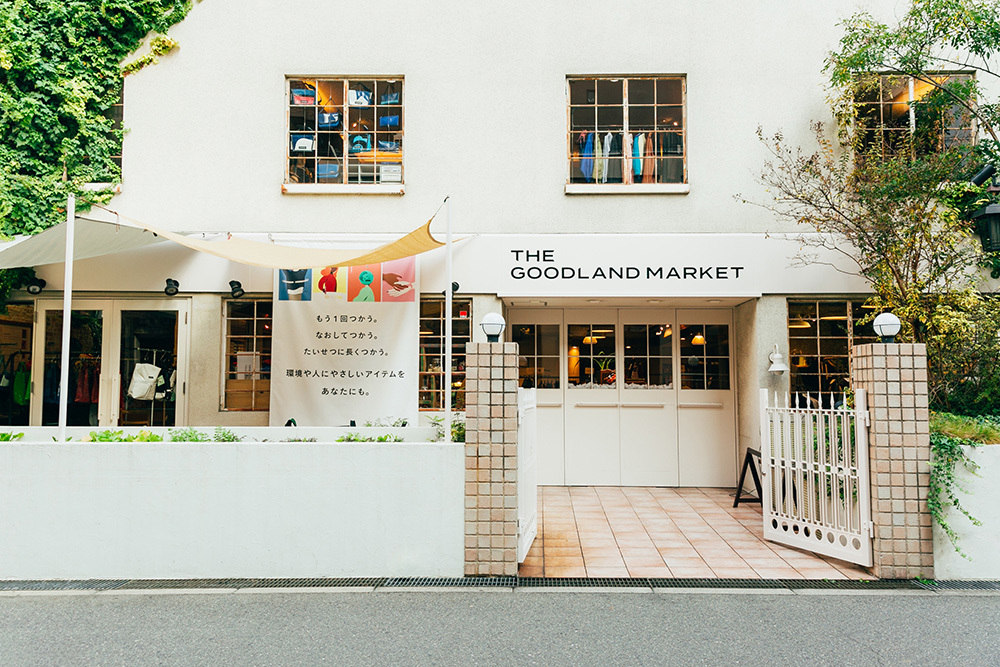
Tozaki: Given that sustainability initiatives don't always translate to short-term profits, I imagine internal coordination must have been challenging to develop these activities to this scale. How did the momentum build?
Hagiwara: A major turning point was developing "commpost," an upcycled brand using discarded clothing. Winning multiple awards, including the Ministry of the Environment's Good Life Award, and joining "The Valuable 500" – a global initiative promoting inclusion for people with disabilities – led to significant social recognition. This fostered a sense of conviction and expectation within the company.
Tozaki: It's precisely because you've consistently pursued such initiatives that introducing Re-Creation felt like a natural progression. Could you tell us about the products that received certification this time?
Hagiwara: It's the "commpost" brand apparel I mentioned earlier, using 30% recycled cotton and 70% virgin cotton.
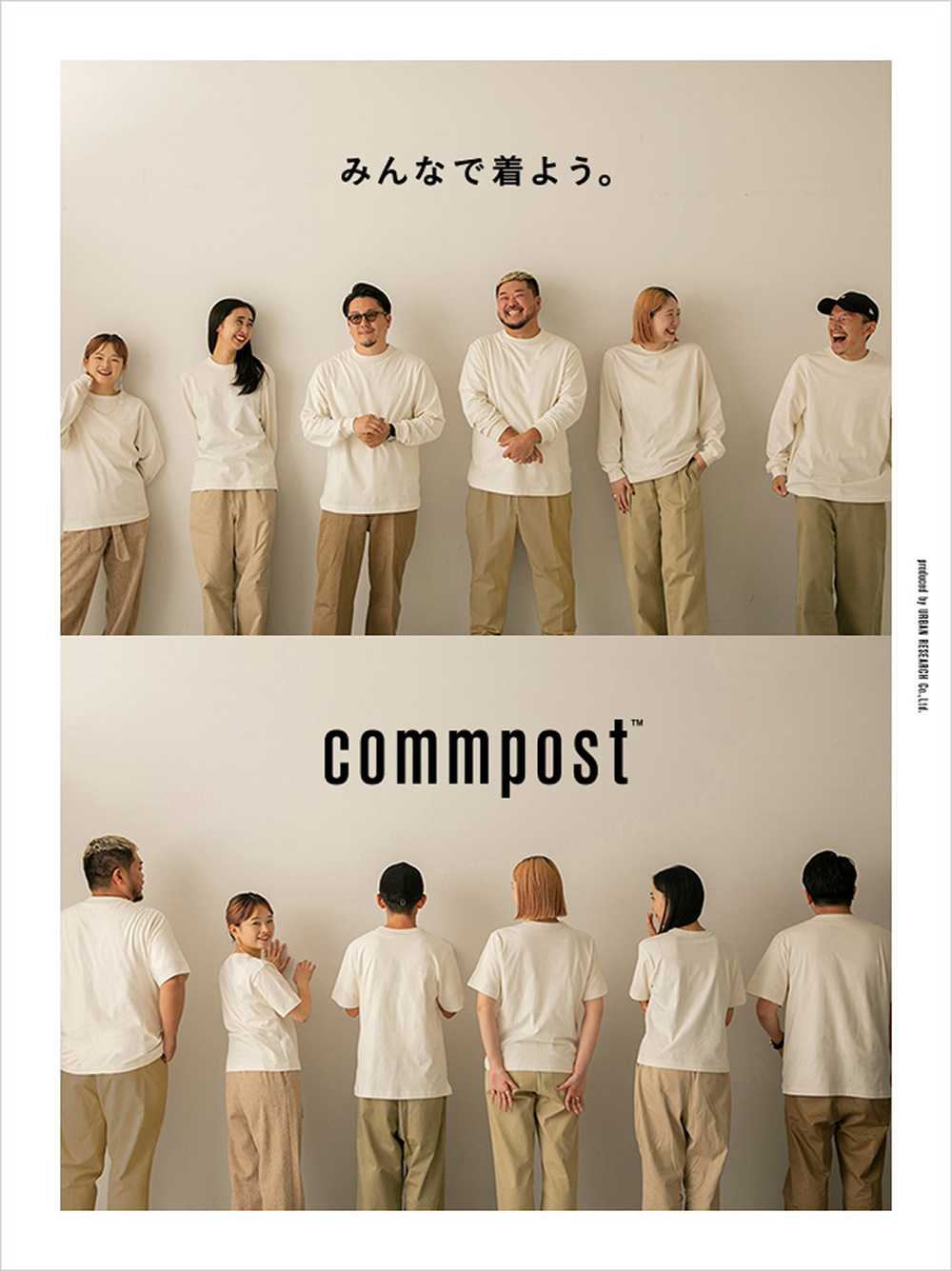
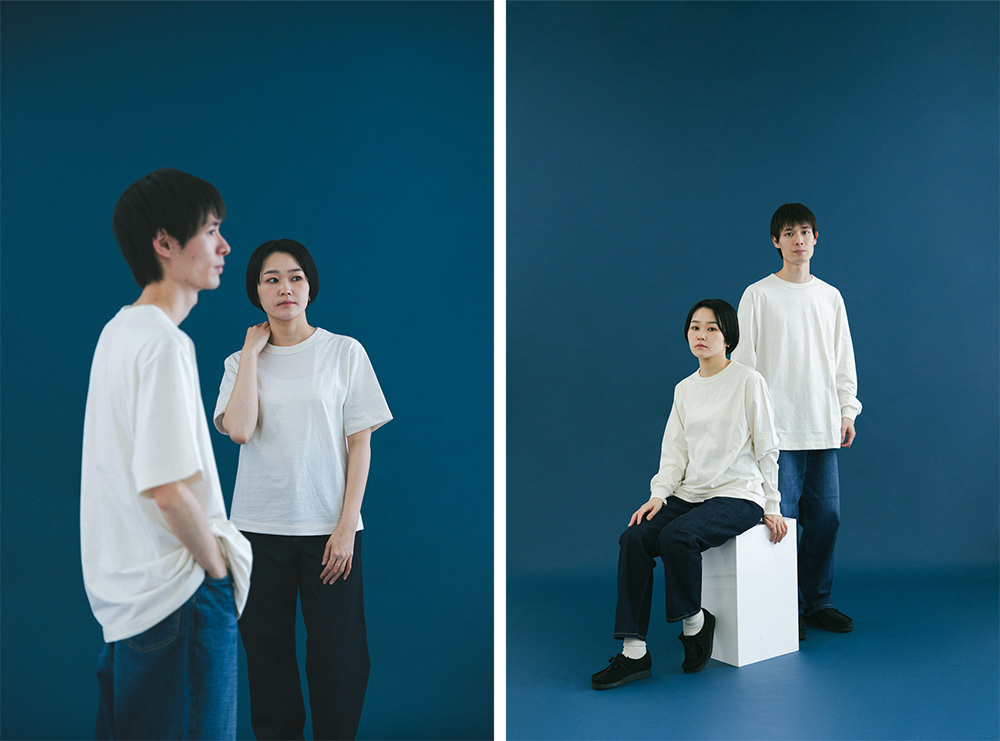
Tozaki: How do you source the recycled materials?
Hagiwara: Primarily from our own defective items and other products slated for disposal. For example, items damaged during manufacturing or ones that have faded in stores, making them difficult to sell. Furthermore, since that alone wasn't sufficient, this time we utilized unsellable towels from Fujitaka, a long-established towel manufacturer in Imabari, as raw material. For Fujitaka, having their products utilized rather than discarded is beneficial, and for us, it allows us to promote resource reuse. This creates a truly valuable cycle for both parties.

Tozaki: Could you also tell us about the certification items applied for this time?
Hagiwara: We applied for two items. One is "Employment Ethics," where the entire production process is completed domestically, meeting the highest Level 3 standard. The other is "Resource Circulation," applying specifically for the use of recycled materials. Domestic production involves higher costs, but precisely because of that, we believe our role is to clearly communicate the enhanced added value. We hope this Re-Creation certification will also serve as a means to convey that value.
Behavioral change begins with awareness. How can we create opportunities for consumers to change?
Tozaki: "Employment Ethics," also included in the Re-Creation certification criteria, can be a bit harder to visualize compared to environmental aspects. How can we best communicate this to consumers?

Yamashita: Our research shows that when "less visible themes" like employment ethics are made transparent, a significant impact occurs if the imagined reality of the workplace differs from the actual conditions. In practice, a certain number of people are willing to purchase products that consider employment ethics, even if they cost slightly more, once they understand their choices influence producers' working conditions. However, the accuracy of this information is critically important. That's precisely why we believe it's essential to deliver substantiated information through a trustworthy certification.
Hagiwara: You're absolutely right. For example, if there are two products, Product A and Product B, and Product A costs 10,000 yen because it was produced normally, while Product B costs 12,000 yen because it was produced with consideration for employment ethics and the environment, I think most people would choose Product A based on price alone because they currently have no way of knowing the difference. However, if they knew why there was a 2,000 yen difference, they might choose Product B. If the background of a product can be visualized through certification like Re-Creation, consumers will understand the price difference. I believe certification systems can serve as a mechanism for this. Perhaps it is precisely because the actual situation and background are difficult to see now that topics such as greenwashing arise. I believe that having this kind of certification is very significant in proving that companies are making a genuine effort.
Yamashita: We also feel that many companies are making sincere efforts. However, the reality is that the means to demonstrate this are very limited. There are certification systems overseas, but the cost of obtaining them is high, and many require renewal every year. Therefore, Re-Creation does not set an expiration date for certification and instead adopts a system of examining the state of the product at the time of its creation. As a result, the cost of obtaining certification is reduced, making it a sustainable system.
Tozaki: The ability to register products individually, rather than requiring company or brand-level registration, also seems like a factor that lowers the barrier to participation.
Yamashita: I agree. However, we haven't lowered the certification standards themselves. For example, while factory audits aren't mandatory, we make judgments by thoroughly examining submitted information. If necessary, we also conduct interviews or additional checks to ensure reliability. This flexibility allows us to keep assessment costs down while achieving high-quality certification—a unique feature of Re-Creation.
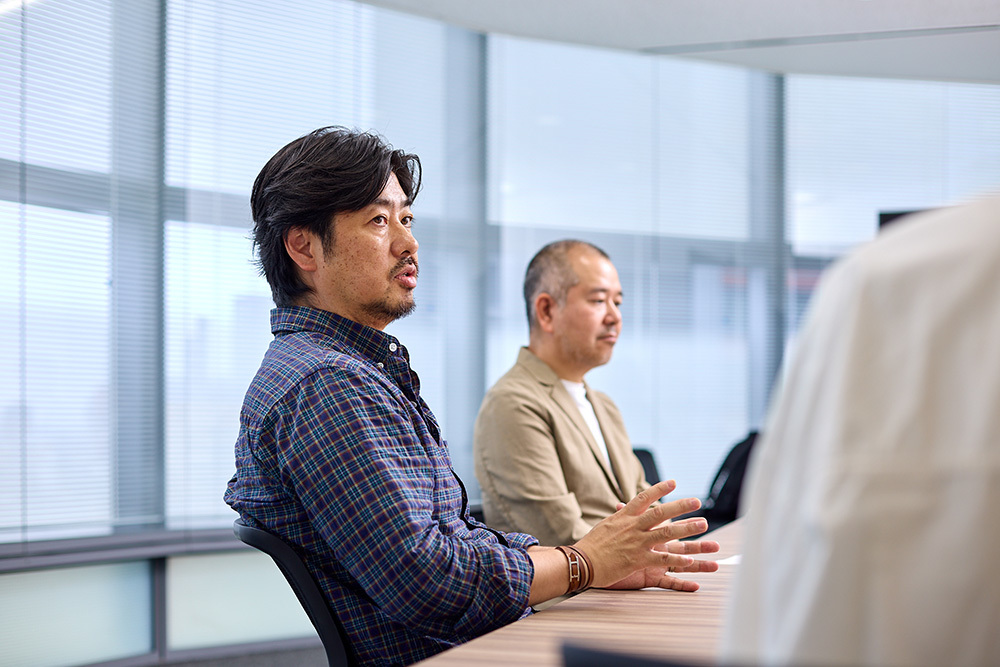
Tozaki: In your daily interactions with Urban Research customers, do you sense an increasing number of voices saying, "Even if it's a bit more expensive, I want to choose products whose background I can relate to"?
Hagiwara: Personally, I feel such voices are gradually increasing. This awareness is particularly strong among the younger generation raised with SDGs education. It seems the mindset of choosing "because it has meaning" rather than "because it's cheap" is taking root.
Yamashita: When designing Re-Creation, we also interviewed university interns. When asked, "What about putting a QR code on the quality tag inside the garment to verify certification information?", most students said it was "fine." However, when asked, "What about putting it on the price tag?", they were negative, saying, "It's something you throw away immediately, and it's a waste of paper." They also pointed out that attaching it to the quality tag would convey value even in the secondary market and could lead to purchasing behavior where people check with their smartphones before visiting the store. They described this as a "new shopping experience" in itself.
Tozaki: It truly symbolizes the new shopping experience of our times.
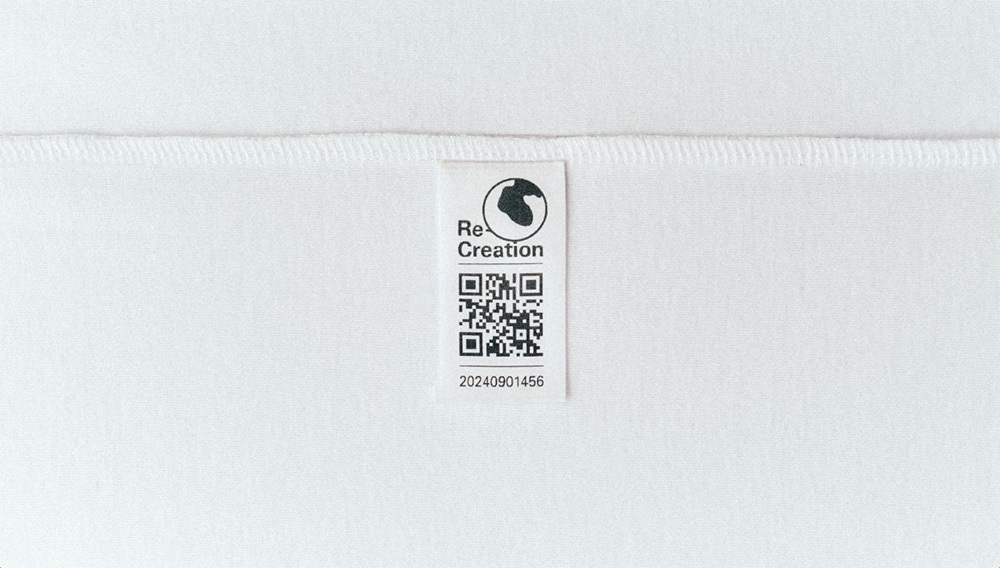
To remain a trusted certification that supports consumers' choices
Togazaki: As the first company to adopt Re-Creation, Urban Research, please share your expectations for Re-Creation and your future outlook for the platform.
Hagiwara: I hope Re-Creation thoroughly certifies products from various brands, and that the value of obtaining certification continues to grow within the industry. As the credibility of the certification body increases, the significance of participation becomes clearer for those registering. We feel fortunate to have been involved in such a promising initiative from the start. If there are future efforts to increase participating companies, we would definitely like to cooperate.
At the same time, we believe we mustn't rest on our laurels just because we're sustainable. It's not about saying, "It's sustainable, so it's okay to be expensive." The fundamental premise is that the product must be appealing in its own right. Beyond that, when comparing Product A priced at ¥10,000 and Product B at ¥12,000, we want to create a situation where customers understand and accept that "Product B isn't just sustainable; it's priced this way because of the value in its materials and design." Imagine a customer drawn to a product's materials or design in-store, picks it up, and then a staff member casually mentions it's also environmentally conscious. That subtle approach embodies the "coolness" we envision, and we want to pursue that.

Yamashita: For us, the most important thing is to faithfully fulfill the promises we've made to everyone who has trusted us and joined us. This is also the top priority for enhancing the credibility of the certification itself.
From a medium-to-long-term perspective, we also envision establishing Re-Creation as an international standard. Currently, countries are advancing their own regulations, but the lack of uniformity makes compliance difficult. Our goal is to create a universal, highly reliable standard that can flexibly address these diverse requirements.
Furthermore, from an ESG perspective, there is potential for future integration with the financial and investment sectors. Indeed, our certification is increasingly being recognized as a valuable metric for ESG and sustainability within integrated reporting. Japan leads globally in the number of integrated reports published, so we intend to develop Re-Creation to fully demonstrate its value in this context.
Tozaki: Having globally recognized common metrics should also facilitate smoother evaluation and comparison, right?

Yamashita: Exactly. Another crucial aspect is the connection with consumers. For brands like Urban Research, which prioritize customer relationships, the system must naturally convey value to the consumers beyond those direct customers.
The fashion industry has long followed a trend of consuming and discarding trends. This is partly due to shifts in economic mechanisms, such as the rise of global SPAs (companies operating a business model where they handle everything from manufacturing to retail and expand overseas), so I don't intend to dismiss it. However, I sense that a new feeling of "wanting to use good things for a long time" is emerging, even among younger generations. Re-Creation incorporates this long-life perspective in response to such shifts in consumer consciousness.
Even in discussions about a circular economy, while the technology might exist today, we still need the rules, economic rationality, and incentive structures to drive it forward. Furthermore, if we send waste overseas instead of processing it domestically to solve capacity issues, that creates its own CO2 emissions problem. In other words, we must focus on both short-term actions and the long-term systems that need building. Re-Creation aims to be a system that combines both perspectives, effectively capturing corporate practices and consumer intent. We want to keep evolving and remain a certification that stays relevant to the times.
Hagiwara: The apparel industry is often called the "world's second most polluting industry," carrying significant responsibility. That's precisely why we need to strengthen horizontal connections and foster momentum for the entire industry to tackle these challenges together. I'd be delighted if Re-Creation could take the lead in this effort.
Was this article helpful?
Newsletter registration is here
We select and publish important news every day
For inquiries about this article
Author

Tetsuya Yamashita
ITOCHU Fashion System Corporation
ifs Future Research Institute
Acting Director
Born in 1974. Joined World Co., Ltd. Served as Head of Corporate Strategy and New Business Development. From 2017, served as Head of Marketing at ITOCHU Fashion System Corporation before establishing a think tank organization. Research specialization is SX; in consulting, handles strategy domains. Sectors covered range from consumer goods to automobiles. In 2024, established the General Incorporated Association Re-Creation with the goal of achieving reproducible SX, concurrently serving as Executive Managing Director.

Naoki Hagiwara
Urban Research Co., Ltd.
Executive Officer
Born in 1973. From Tokyo. Earned an MBA from Queensland University of Technology in Australia. After working at the Ministry of Posts and Telecommunications and an IT company, joined Urban Research in 2013. Served as Executive Officer since 2015 (currently overseeing SDGs and Compliance). Concurrently serves as Director of UR Terrace Co., Ltd., a special subsidiary, since 2019. In 2022, established the Mirai Baton Institute, a general incorporated association, with the aim of leaving a better society and a sustainable global environment for children's futures, serving as its Representative Director.

Ikumi Toga
Dentsu Inc.
Second CR Planning Bureau
Copywriter/Planner
Creative direction and copywriting form the core of my work, which also encompasses branding, business development support from a creative perspective, communication development, product development, and project management. Served as Representative of Dentsu Inc. Gal Lab from 2016 to 2020.


